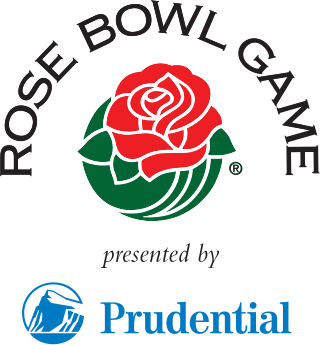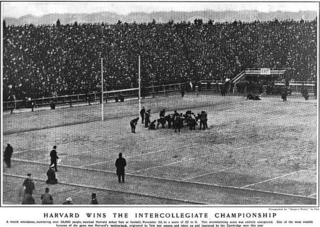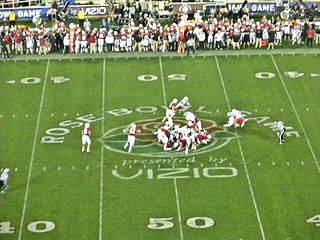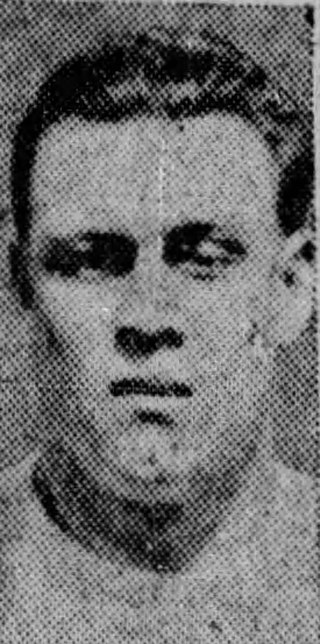Related Research Articles

The Rose Bowl Game is an annual American college football bowl game, traditionally played on January 1 at the Rose Bowl in Pasadena, California. When New Year's Day falls on a Sunday, the game is played on Monday, January 2. Nicknamed "The Granddaddy of Them All" by broadcaster Keith Jackson, it was the first postseason football game ever established. The Rose Bowl Game was first played in 1902 as the Tournament East–West football game, and has been played annually since 1916. Since 1945, it has been the highest attended college football bowl game. The game is a part of the Pasadena Tournament of Roses Association's "America's New Year Celebration", which also includes the historic Rose Parade. Winners of the game received the Leishman Trophy, named for former Tournament of Roses presidents, William L. Leishman and Lathrop K. Leishman who played an important part in the history of this game.
Originally titled the "Tournament East–West football game," what is now known as the Rose Bowl Game was first played on January 1, 1902, at Tournament Park in Pasadena, California, starting the tradition of New Year's Day bowl games.

Hugh White was an American college football player and coach. He played for the University of Michigan from 1898 to 1901, and captained the national championship-winning 1901 team.
The 1926 Stanford football team was an American football team that represented Stanford University in the Pacific Coast Conference (PCC) during the 1926 college football season. In head coach Pop Warner's third season at Stanford, the team compiled a 10–0 record during the regular season, outscored its opponents by a total of 261 to 66, and won the PCC championship. Stanford then faced undefeated Alabama in the 1927 Rose Bowl, which ended in a 7–7 tie.

The 1901 college football season had no clear-cut champion, with NCAA-designated "major selectors" retroactively selecting Michigan and Harvard as national champions. The NCAA records book also erroneously lists Yale as Parke H. Davis's selection. Harvard beat Yale 22–0 the last game of the year.
The 1941 Stanford Indians football team represented Stanford University as a member of the Pacific Coast Conference (PCC) during the 1941 college football season. Second-year head coach Clark Shaughnessy led the team to a 6–3 record. Before the season, Stanford, which the year prior had finished 10–0, was considered a favorite for the national championship, but three conference losses put it out of contention for a return to the Rose Bowl. After the season, Shaughnessy left Stanford to take over as head coach at the University of Maryland.
The 1950 Stanford Indians football team represented Stanford University in the 1950 college football season. Stanford was led by sixth-year head coach Marchmont Schwartz. The team were members of the Pacific Coast Conference and played their home games at Stanford Stadium in Stanford, California.
The 1933 Stanford Indians football team represented Stanford University as a member of the Pacific Coast Conference (PCC) during the 1933 college football season. Led by first-year head coach Claude E. Thornhill, the Indians compiled an overall record of 8–2–1 with a mark of 4–1 in conference play, sharing the PCC title with Oregon. Stanford was invited to the Rose Bowl, where Indians lost to Columbia. The team played home games at Stanford Stadium in Stanford, California.

The 2013 Rose Bowl, the 99th edition of the annual game, was a college football bowl game played on Tuesday, January 1, 2013, at the same-named stadium in Pasadena, California. The Pasadena Tournament of Roses Association is the organizer of the game. The game matched Big Ten Conference Champions Wisconsin Badgers against the Pac-12 Conference Champions Stanford Cardinal, a rematch of the same two teams in the 2000 Rose Bowl. The Cardinal defeated the Badgers 20–14 for the Rose Bowl Championship. This was Wisconsin's third consecutive Rose Bowl defeat.

The 2014 Rose Bowl was a college football bowl game that was played on January 1, 2014, at the Rose Bowl stadium in Pasadena, California. This 100th Rose Bowl Game matched Big Ten Conference Champions Michigan State Spartans against Pac-12 Conference champions Stanford Cardinal. It was one of the 2013–14 bowl games that concluded the 2013 FBS football season. The first game in the final edition of the Bowl Championship Series, it was sponsored by the Vizio consumer electronics company, and officially titled the Rose Bowl Game presented by Vizio.
The 1927 Stanford football team represented Stanford University in the 1927 college football season. In head coach Pop Warner's fourth season, Stanford was undefeated in the Pacific Coast Conference, with a tie in the game against USC. With a three-way tie for the conference championship, Stanford was chosen to represent the conference in the 1928 Rose Bowl against Pittsburgh, with Stanford winning its first Rose Bowl in its fourth attempt, 7–6.
The 1924 Stanford football team represented Stanford University as a member of the Pacific Coast Conference (PCC) during 1924 college football season. Led by first-year head coach was Pop Warner, Stanford compiled an overall record of 7–1–1 with a mark of 3–0–1 in conference play, winning the program's first PCC title. Stanford made its second bowl game appearance, losing to Notre Dame in the Rose Bowl].
The 1935 Stanford Indians football team represented Stanford University in the 1935 college football season. In head coach Claude E. Thornhill's third season, the team was Pacific Coast Conference co-champions with one loss, allowing opponents to score just 13 points all season. This was the third season that the "Vow Boys" kept their vow and defeated USC.
The 1900 Stanford Cardinal football team represented Stanford University in the 1900 college football season. In their first and only season under head coach Fielding H. Yost, the team compiled a 7–2 record, shut out seven of nine opponents, scored 154 points, and allowed 20 points by opponents. The team registered three shutouts against the Reliance Club, two shutouts against California State Normal School, now known as San Jose State University, and single game shutouts against Oregon and California. The team's two losses came against Nevada (0–6) and a Stanford alumni team (0–14) that featured coach Yost playing at the fullback position.

George Richardson Bogue was an American football player.
The 1899 California Golden Bears football team was an American football team that represented the University of California, Berkeley during the 1899 college football season. The team competed as an independent under head coach Garrett Cochran and compiled a record of 7–1–1.
The 1901 California Golden Bears football team was an American football team that represented the University of California as an independent during the 1901 college football season. In its first season under head coach Frank W. Simpson, the team compiled a 9–0–1 record and outscored opponents by a total of 106 to 15.
The 1901 Western Conference football season was the sixth season of college football played by the member schools of the Western Conference and was a part of the 1901 college football season.
The 1968 Sacramento State Hornets football team represented Sacramento State College—now known as California State University, Sacramento—as a member of the Far Western Conference (FWC) during the 1968 NCAA College Division football season. Led by eighth-year head coach Ray Clemons, Sacramento State compiled an overall record of 8–3 with a mark of 4–2 in conference play, placing second in the FWC. The team outscored its opponents 245 to 137 for the season. The Hornets played home games at Hornet Field and Charles C. Hughes Stadium in Sacramento, California.
The 1901 Nevada State Sagebrushers football team was an American football team that represented Nevada State University as an independent during the 1901 college football season. In its first season under head coach Allen Steckle, the team compiled a 3–3 record.
References
- ↑ Migdol, Gary (1997). Stanford: Home of Champions. Sports Publishing LLC. p. 15. ISBN 1-57167-116-1 . Retrieved November 11, 2013.
- ↑ "Stanford Game-by-Game Results; 1901–1905". College Football Data Warehouse. Archived from the original on November 12, 2013. Retrieved November 11, 2013.
- 1 2 "Stanford Football Media Guide" (PDF). Archived from the original (PDF) on March 7, 2013. Retrieved November 11, 2013.
- ↑ "Play Commences For The Season At Stanford And At Berkeley: Cardinal Men Show Great Speed and Clever Team Work". The San Francisco Call. September 29, 1901. p. 24 – via Newspapers.com.
- ↑ "Reliance and Stanford Fail To Score Against Each Other". The San Francisco Examiner. October 6, 1901. p. 38 – via Newspapers.com.
- ↑ "Stanford Ties With The Sturdy Olympic Eleven". The San Francisco Call. October 13, 1901. p. 20 – via Newspapers.com.
- ↑ "The Most Interesting Game of the Year on Stanford Field: Collegians Defeat the Reliance Team by a Score of 10 to 0". The San Francisco Call. October 27, 1901. p. 26 – via Newspapers.com.
- ↑ "Stanford Wins From Nevada". San Francisco Chronicle. November 3, 1901. p. 15 – via Newspapers.com.
- ↑ "California Defeats Stanford in a Fierce Contest on a Stubborn Field". The San Francisco Examiner. November 10, 1901. pp. 1, 18 – via Newspapers.com.
- ↑ "The First Half The Real Thing". Los Angeles Times. January 2, 1902. p. II-4 – via Newspapers.com.
- 1 2 3 "Tournament of Roses History". Archived from the original on January 2, 2007. Retrieved November 11, 2013.